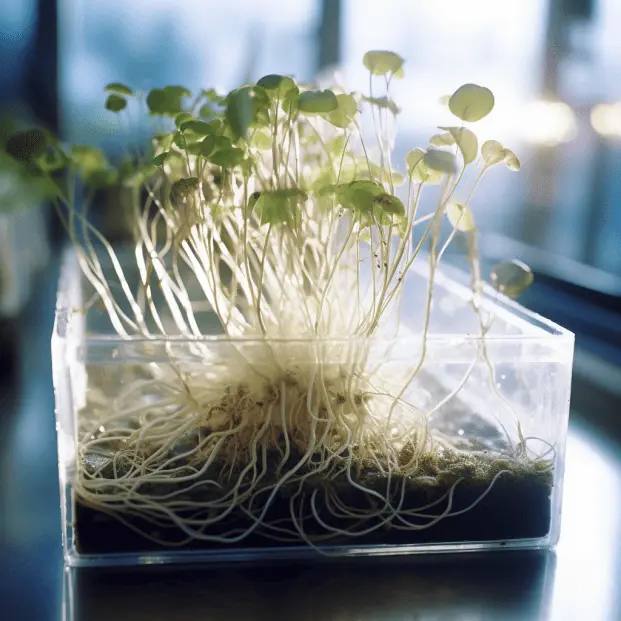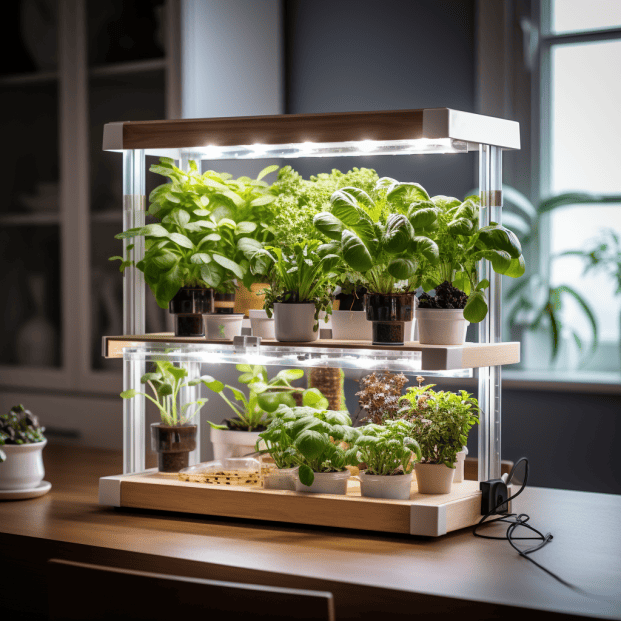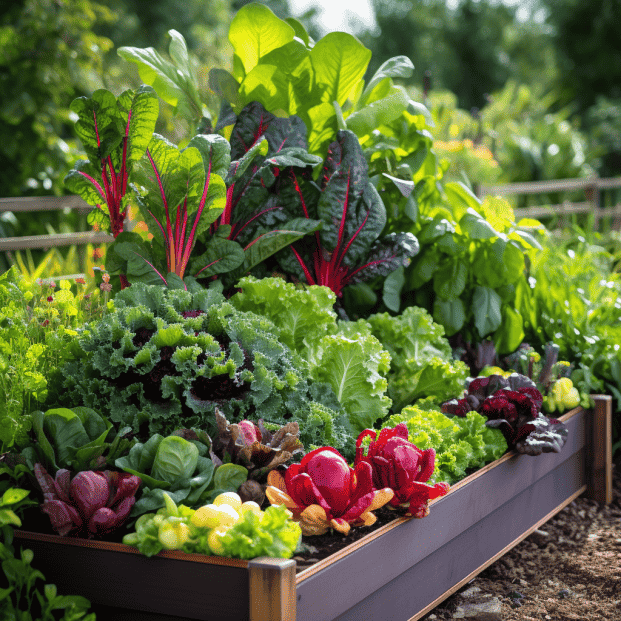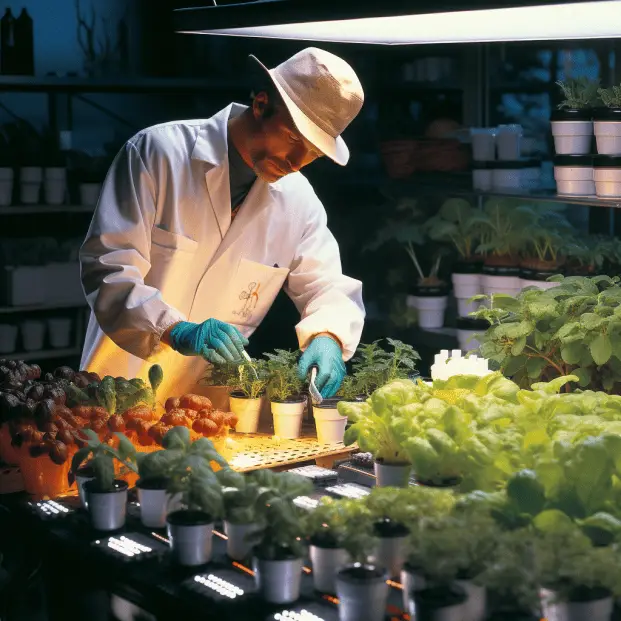Tending hydroponic plants is like dancing a graceful ballet.
While seemingly simple, its choreography demands intricate precision.
As an experienced hydroponic enthusiast, maintaining this alive dance’s delicate balance has taught me much.
Juggling variables from water to nutrients is no laughing matter.
One misstep and your plants pack their petunias! But fear not – I’ll share my pro performance secrets so your hydroponics thrive.
First, changing reservoir water – easy right? Not so fast, Fred! Without properly purified H2O, your dancers may stomp right out.
I once neglected treatment and came home to a toxic black pool dubbing Swan Lake. Yuck!
Next, plant grub.
Without complete nutrient combos, your bush ballerinas couldn’t fouetté to save Hollie Hathaway’s tutu! My first attempt ended Penguin Pandemonium after a missing micronutrient.
Skinny stems everywhere!
Worst of all are algae antics.
These green goblins thrive off neglect like Pizza Fridays in the teacher’s lounge.
Without diligent cleaning, last season my unit turned into a jungle you couldn’t see Spruce Lee’s karate chops in!
Luckily my struggles schooled me well.
Now I know preventing such mishaps protects performance pieces.
So read on, grasshopper!
I’ll spill pro plant secrets so your hydroponics thrive without any soprano-screeching stage fright scenes.
Your green gala is guaranteed if you follow instructions precisely.
The curtain is rising – break a leg!
KEY TAKEAWAY
How to maintain hydroponic plants?
Effective maintenance of hydroponic plants involves regular monitoring, adjusting nutrient levels, ensuring proper lighting, and keeping the root system healthy, leading to robust and flourishing crops. (1)
How Often Should the Hydroponic Reservoir Water be Changed?
When growing plants without soil using the hydroponic method, one important task is ensuring the water in your system’s reservoir stays fresh.
This nutrient-rich water is what the roots rely on to get the food and hydration they need.
Keeping it clean and balanced is key to healthy growth.
So how often should you swap out that reservoir water? The timeframe can vary based on the plants, nutrients used, and your setup, but most hydroponic gardeners find every two to three weeks works well.
This schedule lets nutrients level out without building up too much.
Leaving the water in there too long poses some problems.
Nutrients begin to congregate instead of staying mixed, which can burn delicate roots.
Stagnant water also invites algae and bacteria to multiply.
Before long, your plants are struggling with excess nutrients or diseases rather than thriving.
Conversely, changing the reservoir too often is unnecessary work and wastes nutrients.
Every two to three weeks strikes a harmonious balance.
Frequent swaps keep nutrients balanced without being wasteful.
When it’s time for a change, be sure to scrub your system down top to bottom.
Rinse equipment like pumps and filters to remove any buildup.
A squeaky clean setup ensures nothing but pure nutrient solution reaches those roots.
In summary, maintaining a regular reservoir water change schedule around every two to three weeks is ideal hydroponic care.
It prevents nutrient overload issues while optimizing growth conditions for your plants.
With a little vigilance, you can have your hydroponic garden operating at peak performance!
What is the Best Way to Provide Proper Nutrition for Hydroponic Plants?

Whether growing in soil or without it via hydroponics, healthy plants need proper nutrition. (2)
In an aquaponics system, you feed them through a specially mixed liquid called a nutrient solution.
This carefully formulated liquid carries all the vitamins, minerals, and other sustenance roots suck up for strong growth above and below the surface.
Of course, nutrients are only helpful if dosed at the right levels.
Too little or too much of any one element causes problems ranging from sluggishness to toxicity.
That’s why diligent monitoring is important to maintain balance.
Hydroponic gardeners commonly rely on tools like EC (electrical conductivity) and pH meters.
EC measures salt concentrations to indicate nutrient quantities, while pH detects if the solution is too alkaline or acidic for roots to take full advantage.
Striking the suitable numbers produces vigorous, confident plants.
When checks show numbers away from the ideal zones, it’s time for adjustments.
Some nutrients may need boosting with supplemental mixing, while others require decrease.
How much depends on readings and crop needs during each stage.
Consult feeding charts tailored for your system and crop to refine the right blend.
Achieving optimal nutrition requires regular attention, but reaps huge rewards.
Healthy, happening plants translate to bigger harvests and less aggravation down the road.
Taking the time to learn monitoring techniques empowers precision feeding for top-notch results indoors or out.
How Can You Maintain the Ideal pH Levels in a Hydroponic System?

Keeping pH in line holds great importance for hydroponics enthusiasts.
This simple measurement represents acidity or alkalinity, deciding whether key minerals dissolve and become available to roots.
When out of whack, pH imbalances can induce nutrient deficiencies or toxicities that undermine your harvest.
Thankfully, maintaining suitable levels takes minimal effort.
I monitor the pH of my system’s nutrient solution regularly using a digital pH probe.
If readings skew high or low from the 5.5-6.5 “sweet spot”, adjustments become necessary.
For overly alkaline solutions, I introduce trace amounts of phosphoric acid – a mild yet effective balancer.
If pH runs too far on the acidic side, it’s a cue to gently raise levels back into safety using potassium hydroxide.
Tweak quantities gradually and recheck until smack in the target zone.
Quick, minor shifts tend to cause fewer further fluctuations than drastic interventions.
With some trial and error, I’ve found reliable methods that keep pH suitably stable.
My thriving plants show that consistent levels unlock maximum nutrient absorption and root health.
Achieving proper pH demands attention, yet its impact outweighs the minimal time.
Healthy hydroponics depend on balanced solutions, beginning first with ensuring nutrients dissolve and transport essential elements to fuel plant welfare.
This foundational aspect stays easily in one’s control, helping crops look their brightest at every stage.
What Type of Lighting is Needed for Robust Hydroponic Plant Growth?

While hydroponics eliminates the need for soil, one requirement remains the same – plants must have light sufficient for photosynthesis.
With it, they transform water, minerals and carbon dioxide into the sugars, carbohydrates and proteins essential for growth and reproduction.
Just as different crops and environments impact lighting needs outdoors, so too does hydro setup style factor indoors.
Here are some key considerations:
Intensity matters most.
Hydro crops demand powerful light at growing areas equating to full sun.
Intensity gauges photon flux delivered in micromoles per square meter.
Spectrum also counts.
Blue light drives vegetative phases, while red boosts flowering and fruiting.
Full spectrum covers all.
Timing makes an impact.
Young crops get up to 16 hours daily, while 12-14 hours suits most mature plants vegetatively.
Flowering slice requires eight to 10 hours.
Fixtures require care.
Cleaning prevents dust coating lenses from dimming output wattage paid for.
Replace aging bulbs promptly for consistent performance.
With diligent attention to harnessing sunlight artificially, harvest sizes amplify.
Quality lighting motivates hydroponics’ bounty potential regardless of setting.
Efficient fixtures and schedules optimize growth far better than straining under weak illumination.
How Can You Prevent Issues Like Algae Growth and Root Rot?
Keeping surroundings clean prevents problems everyone dislikes – like murky algae or mushy root rot.
Small adjustments avoid such hassles, streamlining healthy plant care indoors.
Algae multiply given moisture, nutrition and lighting.
Routinely topping off reservoir levels depletes oversaturation allowing algal establishment.
Blackout cropping areas and covering reservoirs interrupts necessary solar energy.
Monitoring nutrients cuts excess availability and green water weeds feast upon.
Root rot arises due to waterlogged, oxygen-starved roots.
Good airflow circulation using computer fans moves air around.
Air stones or passive diffusers aerate root zones continuously within reservoirs or flood/drain tables.
Ensuring sufficient drainage avoids soggy medium compacting and eliminates standing water harboring pathogens.
Maintaining clean conditions demands minimal effort sustaining robust harvest quality.
Checking parameters addresses potential issues preemptively.
Vigilant growers enjoy seamless crop cycles focused on maximizing plant potential rather than combatting nuisances entirely avoidable with proactive prevention practices.
Clean hydroponics simplify success!
When Should You Flush and Deep Clean the Hydroponic System?
To keep a hydroponic system running smoothly, flushing and deep cleaning holds importance.
Over time, residue builds within no matter how pristine maintenance.
Performing thorough cleanings ensures nothing hinders your plants’ access to nutrient rich water indispensible for bountiful blooms.
So what’s the best timing and process?
Most hydroponic gardeners find every 2-4 weeks appropriate.
Some signs necessitating cleaning include declining plant health, cloudy nutrient solution or algal growths.
Drain your reservoir then and pull out all plants to clean undisturbed.
Rinsing every nook and cranny with water proves a great first step.
Brushes gently scrub away any films.
Then, mixing a hydroponic-safe cleanser per package instructions tackles stuck on gunk more efficiently and safely than harsh chemicals.
Wear gloves and thoroughly wipe down all surfaces.
Refilling your reservoir with newly mixed nutrients completes the process.
Replace your flushed plants and observe new growth resulting from a now-immaculate root environment!
Periodic refreshment unclogs buildups ensuring consistent, uncompromised access those roots rely on.
Taking 30 minutes maintains bacterial/fungal balance protecting your harvest investment.
Clean hydroponics translates to thriving plants!
What Are Early Signs of Problems in Roots and Plants to Watch For?
Keeping a watchful eye avoids little issues becoming dangerous dilemmas.
Common hydroponics hindrances exhibit tell-tale signs appearing before inflicting maximum harm.
Catching clues early facilitates prompt remedies maximizing yields.
Nutrient deficient or imbalanced plants display yellowing leaves or slowed growth.
Make sure solutions contain proper amounts according to plant stage.
Soggy, oxygen-starved roots rot rather than thrive.
Increased airflow and batch watering prevents oversaturation.
Pay close root attention to uncovering creeping concerns in initial phases.
Healthy underground systems remain white, firm and vibrantly collaborative with your hydroponics endeavor.
Slime coatings or dark discoloration indicate impending rot requiring fast action.
Sometimes identifying problems owes to less visible cues.
Notice any solution changes like unusual cloudiness or odors.
Give whole systems a sniff or visual exam uncovering oddities stunting crops.
Nip such subtle signs in the bud before escalating.
Regular plant checkups enable quick diagnosis and simple fixes.
Knowing normalcy assists anomaly awareness.
Catching kitchen sink issues when minors prevents pests becoming overwhelming plagues.
With hydroponics minimizing manually labor, vigilantly watching for warning signs.
Conclusion
After diving deep into the world of hydroponic plant care, I’ve come to realize that maintaining these plants is like conducting a delicate symphony.
Just as a conductor guides each instrument to create beautiful music, we must carefully monitor and adjust the water, nutrition, pH levels, lighting, and cleanliness of our hydroponic systems.
By staying vigilant for early signs of trouble in roots and plants, we can prevent issues such as algae growth and root rot.
So let’s embrace the role of maestro and create a thriving hydroponic garden!
References
- https://hydroponicway.com/5-tips-to-grow-healthy-plants/
- https://extension.psu.edu/hydroponics-systems-and-principles-of-plant-nutrition-essential-nutrients-function-deficiency-and-excess
Related Articles
- https://tophydroponicgarden.com/how-to-maintain-your-first-hydroponic-garden/
- https://tophydroponicgarden.com/what-hydroponic-solution-for-beginners/
- https://tophydroponicgarden.com/items-needed-for-hydroponic-system/
Was this helpful?

Crystal Erickson is an agriculture enthusiast and writer with a passion for sustainable farming practices and community development. Growing up on a family farm in rural Iowa, Crystal developed a love for the land and a deep appreciation for the hard work and dedication required to make a farm successful.
After completing a degree in Agriculture and Environmental Science from Iowa State University, Crystal began her career as an agricultural journalist, covering stories and issues related to modern farming practices, crop management, and livestock production. She quickly established herself as a respected voice in the industry, known for her insightful reporting and thoughtful analysis.
Over the years, Crystal has written for a variety of publications, including Farm Journal, Successful Farming, and Modern Farmer, as well as contributing to several academic journals focused on sustainable agriculture and community development. Her work has been recognized with numerous awards, including the Iowa Farm Bureau’s Young Farmer Achievement Award and the National Association of Farm Broadcasting’s Farm Broadcaster of the Year.


